| Listing 1 - 10 of 20 | << page >> |
Sort by
|
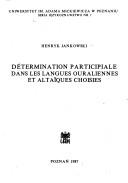
ISBN: 8323200572 9788323200574 Year: 1987 Volume: 7
Abstract | Keywords | Export | Availability | Bookmark
 Loading...
Loading...Choose an application
- Reference Manager
- EndNote
- RefWorks (Direct export to RefWorks)
Ural-Altaic languages --- Participle --- Determiners --- -Ural-Altaic languages --- -Scythian languages --- Turanian languages --- Altaic languages --- Samoyedic languages --- -Participle --- Scythian languages --- Ural-Altaic languages - Participle --- Ural-Altaic languages - Determiners
Book
ISBN: 9519380035 9789519380032 Year: 1987 Volume: 59 Publisher: Helsinki: Finnish oriental society,
Abstract | Keywords | Export | Availability | Bookmark
 Loading...
Loading...Choose an application
- Reference Manager
- EndNote
- RefWorks (Direct export to RefWorks)
Altaic languages --- Philology --- Scythian languages --- Proto-Altaic language --- Ural-Altaic languages --- Festschrift - Libri Amicorum --- Transeurasian languages
Book
ISBN: 9004351981 9004351957 Year: 2017 Publisher: Leiden ; Boston : Brill,
Abstract | Keywords | Export | Availability | Bookmark
 Loading...
Loading...Choose an application
- Reference Manager
- EndNote
- RefWorks (Direct export to RefWorks)
Professor György Kara, an outstanding member of academia, celebrated his 80th birthday recently. His students and colleagues commemorate this occasion with papers on a wide range of topics in Altaic Studies, with a focus on the literacy, culture and languages of the steppe civilizations.
Altaic philology. --- Altaic languages. --- Scythian languages --- Transeurasian languages --- Proto-Altaic language --- Ural-Altaic languages
Periodical
ISSN: 26771268 Year: 1973 Publisher: Szeged : Universitas Szegediensis de Attila József Nominata
Abstract | Keywords | Export | Availability | Bookmark
 Loading...
Loading...Choose an application
- Reference Manager
- EndNote
- RefWorks (Direct export to RefWorks)
Ural-Altaic languages. --- Ural-Altaic philology. --- Scythian languages --- Turanian languages --- Altaic languages --- Samoyedic languages
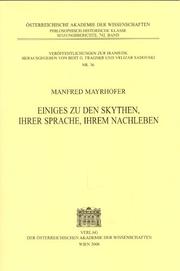
ISBN: 9783700137313 3700137311 Year: 2006 Volume: 742 36 Publisher: Wien Österreichische Akademie der Wissenschaften
Abstract | Keywords | Export | Availability | Bookmark
 Loading...
Loading...Choose an application
- Reference Manager
- EndNote
- RefWorks (Direct export to RefWorks)
Scythians --- Altaic languages --- Altaic languages. --- Scythians. --- Scythen. --- Taalverwantschap. --- Iranians --- Sauromatians --- Scythian languages --- Proto-Altaic language --- Ural-Altaic languages --- Transeurasian languages
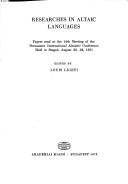
ISBN: 9630501244 Year: 1975 Publisher: Budapest Akadémiai Kiadó
Abstract | Keywords | Export | Availability | Bookmark
 Loading...
Loading...Choose an application
- Reference Manager
- EndNote
- RefWorks (Direct export to RefWorks)
Altaic languages --- Congresses. --- S32/0400 --- Scythian languages --- Transeurasian languages --- Proto-Altaic language --- Ural-Altaic languages --- Congresses --- Central Asia--Altaic languages
Book
ISBN: 1299283764 902727214X 9789027272140 9789027205995 902720599X Year: 2013 Publisher: Amsterdam
Abstract | Keywords | Export | Availability | Bookmark
 Loading...
Loading...Choose an application
- Reference Manager
- EndNote
- RefWorks (Direct export to RefWorks)
Double-negative periphrastic litotes have been for nearly three centuries the usual way to express necessitive predicates in Japanese and Korean. These constructions do not, however, go back to the earliest stages of these languages and should not be invoked as evidence of a possible common origin. But Korean also has a double-affirmative periphrastic necessitive construction. Premodern Japanese has no overt counterpart to it, but it does have an auxiliary adjective that expresses necessity. I argue that this auxiliary was a grammaticalization of a periphrastic analogous in form and meaning to
Altaic languages --- Scythian languages --- Transeurasian languages --- Proto-Altaic language --- Ural-Altaic languages --- Grammaticalization. --- Grammar, Comparative. --- Morphology. --- Syntax.
Book
ISBN: 9789027205995 Year: 2013 Volume: 132 Publisher: Amsterdam Benjamins
Abstract | Keywords | Export | Availability | Bookmark
 Loading...
Loading...Choose an application
- Reference Manager
- EndNote
- RefWorks (Direct export to RefWorks)
Ural-Altaic languages --- Grammar --- Altaic languages --- Grammaticalization. --- Grammar, Comparative. --- Morphology. --- Syntax. --- Scythian languages --- Proto-Altaic language --- Grammar, Comparative --- Grammaticalization --- Morphology --- Syntax --- Transeurasian languages
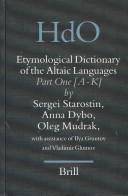

ISBN: 9004131531 9004132902 9004132910 9004132929 Year: 2003 Volume: 8
Abstract | Keywords | Export | Availability | Bookmark
 Loading...
Loading...Choose an application
- Reference Manager
- EndNote
- RefWorks (Direct export to RefWorks)
Altaic languages --- Langues altaïques --- Etymology --- Dictionaries --- Etymologie --- Dictionnaires --- Langues altaïques --- Scythian languages --- Proto-Altaic language --- Ural-Altaic languages --- Transeurasian languages --- Dictionaries.
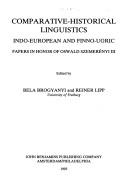
ISSN: 03040763 ISBN: 9027235988 1556191596 9786613312976 1283312972 9027276986 9789027276988 9789027235985 9781556191596 9781283312974 6613312975 Year: 1993 Volume: 97 Publisher: Amsterdam ; Philadelphia : J. Benjamins Pub. Co.,
Abstract | Keywords | Export | Availability | Bookmark
 Loading...
Loading...Choose an application
- Reference Manager
- EndNote
- RefWorks (Direct export to RefWorks)
This volume offers an important contribution to the comparative historical study of languages. Most of the articles deal with topics concerning the Indo-European proto-language as well as the individual languages descended from it. Essays in Finno-Ugric philology complete the volume. The book is divided in 8 sections: I. Indo-European, II. Anatolian, III. Indic, IV. Iranian and Armenian, V. Celtic, VI. Germanic Languages, VII. Slavic and Albanian, VIII. Fennougrica and Altaica.
Indo-European languages --- Ural-Altaic languages --- Indo-European languages. --- Ural-Altaic languages. --- Scythian languages --- Turanian languages --- Altaic languages --- Samoyedic languages --- Aryan languages --- Indo-Germanic languages
| Listing 1 - 10 of 20 | << page >> |
Sort by
|

 Search
Search Feedback
Feedback About UniCat
About UniCat  Help
Help News
News